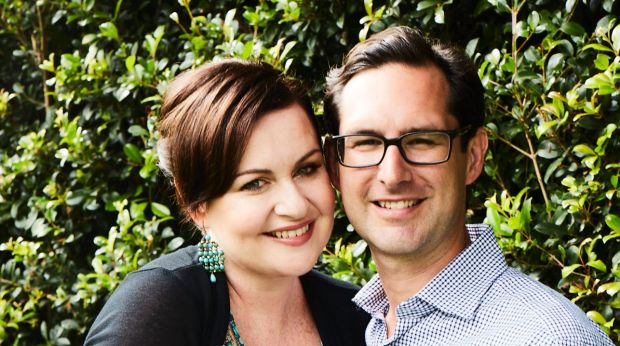When Ann Maree Mulders woke up still feeling unwell, she didn't know 11 centimetres was about to change her life.
She didn't know her latest visit to the doctor to deal with her vague everyday symptoms – general queasiness, bloating, occasional abdominal pain – and the terrifying answer would leave her with the same treatment options her grandmother's generation would have faced.
More National News Videos
How cancer out-smarts treatment
Australian researchers have identified four key ways by which one of the most common type of ovarian cancers becomes resistant to chemotherapy.
And she didn't know that being one of the few to survive it would leave her as one of the only ambassadors Ovarian Cancer Australia could call on, to raise some desperately needed awareness about the insidious disease that leaves only 43 out of 100 women diagnosed alive after five years.
Three years after that 11cm tumour was discovered on her ovary and just over two since finishing chemotherapy, Ann Maree – Annie – is in remission and hugging her beautiful young sons, Matthew and Lachlan, every day.

One of her best friends, Bridget Whelan – a woman she had known since high school and who was also diagnosed with ovarian cancer – is not.
Last week, Annie's story brought women from across the political divide, including the Coalition's Kelly O'Dwyer, Labor's Gai Brodtmann, One Nation's Pauline Hanson and the Greens' Sarah Hanson-Young to tears, uniting them in compassion for women faced with a disease the statistics say will impact one in four.
Annie knows that feeling well. It's how she felt before an ultrasound revealed her own invader.
"The outcomes one is faced with, when diagnosed with ovarian cancer, are enough to scare the hell out of anyone," she said.

"They say it's rare, but the mortality numbers aren't rare. The more you read the more scared and alone you feel.
"Ovarian cancer has a minuscule 43 per cent five-year survival rate. To compare – breast and prostate cancer have 90 per cent and 94 per cent survival rate after five years. It seems impossible, but it's true.

"Over 1000 women die every year from ovarian cancer because there are not enough effective treatment options. Put simply – the drugs don't work well enough and there are has been little development or evolution in treatment for over 30 years.
"We desperately need research to discover new effective treatment options to keep women diagnosed alive. And that research requires funding. The harsh reality is there are not enough survivors to champion the ovarian cancer cause because too many of them are dead."

Chief executive officer of Ovarian Cancer Australia, Jane Hill, is working to change that.
The nation's politicians already wear teal ribbons in recognition of one of Australia's deadliest, but forgotten, cancers. They have pledged their hope for better outcomes. Ms Hill hopes they'll send some funding along with it.
She, and those who work alongside her, are hoping for the establishment of a clinical registry, to track individual ovarian cancer cases, and hopefully reveal trends, showing which types of ovarian cancers respond well to which treatment. At the moment, doctors don't know enough about how the cancer works and how best to combat it.
The options they present to women are the same they put forward when their grandmother's generation was faced with the same diagnosis.
"Ovarian cancer is a mind-bendingly cruel disease because the survival rates are so poor," Ms Hill said.
"Although women go into remission, the majority relapse which then starts a cycle of chemotherapy followed by a period of remission, then recurrence, more chemotherapy, remission and then more chemotherapy again until it gets to the point where the cancer becomes resistant to the chemotherapy.
"That's a really cruel trajectory for women so we also need funding for psychosocial support services to support women all over Australia, including those in regional and remote areas, who have this disease."
Based on available data, just under $55 million was invested in ovarian cancer research between 2008-13.
The National Breast Cancer Foundation was able to raise almost half of that, in one year of fundraising.
But there was a time when no one talked about breast cancer, when a lump in breast tissue carried with it a loss of hope.
No one thinks about their ovaries until something goes wrong with them, Annie said.
But she's hopeful her message will help bring about a shift. It's already changing lives – the event at Parliament House last week taught Senator Hanson ovarian cancer cannot be detected through a pap smear.
The One Nation leader was visibly moved by what she had heard that night. And it put one more person in a position of budget influence in their corner. In the meantime, Annie will keep answering the call to speak up for ovarian cancer, because she knows their roster of survivors is short.
And she'll keep bombarding her eight and 10-year-old sons, and husband Christian, with photo opportunities and laughter.
"Women living with this disease don't want to be considered a lost cause," she said. "We want the chance to survive."
Symptoms of ovarian cancer
- Feeling full after only eating a small amount.
- Persistent bloating.
- Change in bowel and urinary habits/need to urinate often.
- Abdominal pressure or discomfort.
- Excessive fatigue.
- Indigestion.
- Appetite loss.
- Unexplained weight loss/gain.
- Irregular periods/post menopausal bleeding.
There is no early detection test. If symptoms persist, ask for an ultrasound.
















3 comments
New User? Sign up